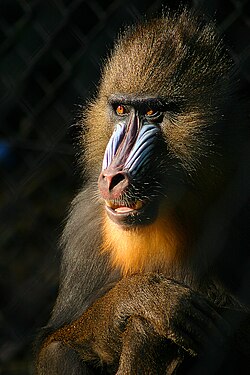| Papionini Temporal range: Pliocene to present | |
|---|---|
 | |
| Mandrill (Mandrillus sphinx) in Germany | |
| Scientific classification | |
| Kingdom: | Animalia |
| Phylum: | Chordata |
| Class: | Mammalia |
| Order: | Primates |
| Suborder: | Haplorhini |
| Infraorder: | Simiiformes |
| Family: | Cercopithecidae |
| Subfamily: | Cercopithecinae |
| Tribe: | Papionini Burnett, 1828 |
| Type genus | |
| Papio Erxleben, 1777 | |
| Genera | |
See text | |
Papionini is a tribe of Old World monkeys that includes several large monkey species, which include the macaques of North Africa and Asia, as well as the baboons, geladas, mangabeys, kipunji, drills, and mandrills, which are essentially from sub-Saharan Africa (although some baboons also occur in southern Arabia). [1] It is typically divided into two subtribes: Macacina for the genus Macaca and its extinct relatives and the Papionina for all other genera. [2] [3]



